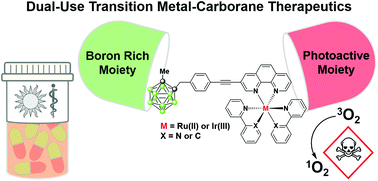Ru(ii) and Ir(iii) phenanthroline-based photosensitisers bearing o-carborane: PDT agents with boron carriers for potential BNCT†
Abstract
Four novel transition metal-carborane photosensitisers were prepared by Sonogashira cross-coupling of 1-(4-ethynylbenzyl)-2-methyl-o-carborane (A-CB) with halogenated Ru(II)- or Ir(III)-phenanthroline complexes. The resulting boron-rich complexes with one (RuCB and IrCB) or two carborane cages (RuCB2 and IrCB2) were spectroscopically characterised, and their photophysical properties investigated. RuCB displayed the most attractive photophysical properties in solution (λem 635 nm, τT 2.53 μs, and φp 20.4%). Nanosecond time-resolved transient absorption studies were used to explore the 3MLCT nature of the triplet excited states, and the highest singlet oxygen quantum yields (ΦΔ) were obtained for the mono-carborane-phenanthroline complexes (RuCB: 52% and IrCB: 25%). None of the complexes produce dark toxicity in SKBR-3 cells after incubation under photodynamic therapy (PDT) conditions. Remarkably, mono-carboranes RuCB and IrCB were the best internalised by the SKBR-3 cells, demonstrating the first examples of tris-bidentate transition metal-carborane complexes acting as triplet photosensitisers for PDT with a high photoactivity; RuCB or IrCB killed ∼50% of SKBR-3 cells at 10 μM after irradiation. Therefore, the high-boron content and the photoactive properties of these photosensitisers make them potential candidates as dual anti-cancer agents for PDT and Boron Neutron Capture Therapy (BNCT).



 Please wait while we load your content...
Please wait while we load your content...